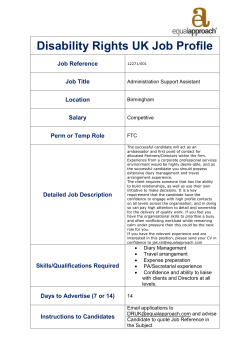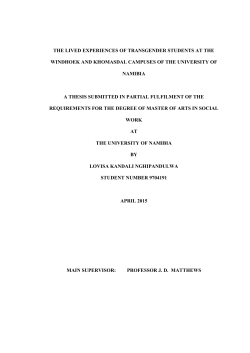
Survey - MSN.com
NBC News Online Survey: Public Opinion on Caitlyn Jenner and Transgender Bias Embargoed for release after 6:00 AM Tuesday, June 9, 2015 Americans Say Caitlyn Jenner’s Public Transition Will Grow Acceptance of Transgender Persons A majority of Americans acknowledge that transgender people face substantial prejudice in our country, according to the most recent NBC News online survey conducted by SurveyMonkey. TOPLINES Questions 1-29 held for future releases. 30. How much stigma or negative social judgment, if any, do you think a transgender person faces in your community? 6.3-5.15 A lot Some Only a little None at all DK/NA 45 37 11 6 2 31. Looking ahead 10 years from now, do you think the level of social acceptance of transgender people in this country will be a lot more accepting, a little more accepting, no different, a little less accepting, or a lot less accepting? 6.3-5.15 A lot more accepting 29 A little more accepting 47 No different 18 A little less accepting 2 A lot less accepting 3 DK/NA 2 32. Caitlyn Jenner, the transgender Olympic champion formerly known as Bruce Jenner, recently revealed her transition on the cover of Vanity Fair. Do you think Caitlyn Jenner’s public transition will help society become more accepting of transgender people? Will help a lot Will help a little Will not help DK/NA 6.3-5.15 20 46 32 2 METHODOLOGY The NBC News Online Survey was conducted online by SurveyMonkey June 3-5, 2015 among a national sample of 2,153 adults aged 18 and over, including an oversample of 260 U.S. adults with an education level of high school or less. Respondents for this non-probability survey were selected from among those who have volunteered to participate in the SurveyMonkey 1 Audience panel. This SurveyMonkey Audience project was run using a balanced sample. The process of sample balancing starts by setting targets for desired numbers of completed responses among certain groups (in this case: by gender, age, and race groupings). After that, a specified number of potential respondents are allocated to the project based on expected completion rates. Panelists are either linked directly to the survey from an email invitation, or routed to the survey after agreeing to take an additional survey after completing a prior one. Once the survey is put into the field, the system calculates actual completion rates by group, and uses that information to re-adjust the flow of new panelists to the survey. SurveyMonkey panelists are emailed no more than once every three days, and on average panelists receive one email every two weeks. SurveyMonkey also imposes a daily limit on the number of surveys a panelist can take. Data for this survey have been weighted for age, race, sex, education, and division using the Census Bureau’s American Community Survey, marital status using the Current Population Survey, along with data from the Kaiser Health Tracking Poll on evangelicalism and the Pew Research Center on religious attendance to reflect the demographic composition of the United States. Because the sample is based on those who initially self-selected for participation rather than a probability sample, no estimates of sampling error can be calculated. All surveys may be subject to multiple sources of error, including, but not limited to sampling error, coverage error, and measurement error. To assess the variability in the estimates and account for design effects, we create a bootstrap confidence interval, meaning we use the weighted data to generate 1000 independent samples and calculate the standard deviation of the weighted average using those samples, producing an error estimate. When analyzing the survey results and their accuracy, this error estimate should be taken into consideration in much the same way that analysis of probability polls takes into account the margin of sampling error. For example, if 47 percent of voters say they support Candidate A and 43 percent of voters support Candidate B, and the error estimate is plus or minus 3.5 percentage points, Candidate A could be supported by as low as 44 percent of voters and Candidate B could have as high as 47 percent of support. Therefore, Candidate A does not have a "lead." The following table provides the unweighted sample sizes and the error estimate that has been calculated in place of the margin of sampling error for a variable that is expected to have close to an even split in most groupings (such as gender): Group Unweighted N Total sample 2153 Plus or minus 3.0 percentage points Republican 6.8 percentage points 385 2 Democrat Independent 864 860 4.5 percentage points 4.4 percentage points 18-29 30-44 45-59 60+ 415 598 582 556 6.4 percentage points 5.6 percentage points 5.6 percentage points 5.9 percentage points White Black Hispanic Other 1506 184 235 186 3.5 percentage points 9.2 percentage points 8.5 percentage points 9.9 percentage points LGBT 155 10.6 percentage points 3
© Copyright 2025










